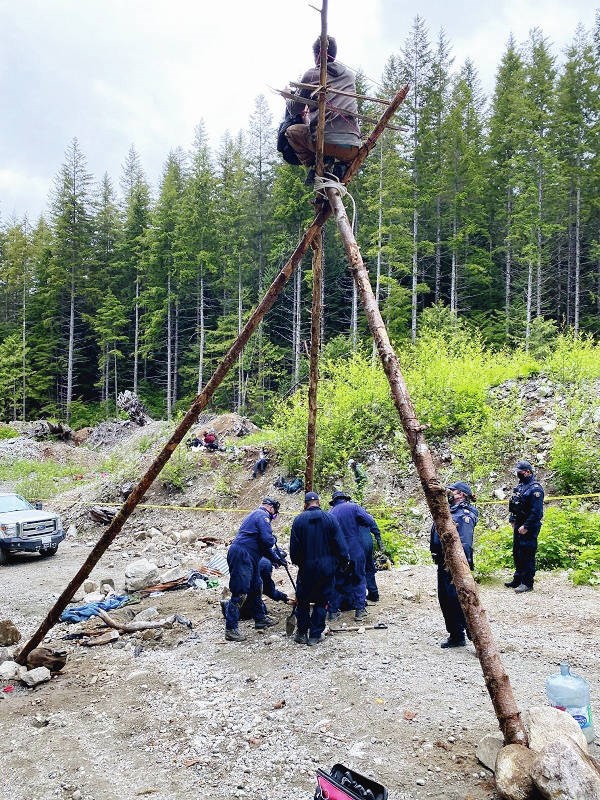Despite the recent deferral on old-growth logging in the Fairy Creek watershed and Central Walbran areas, the Fairy Creek protests continue.
The deferral suspends logging on 2,034 hectares in those areas for two years. Requested by the Huu-ay-aht, Ditidaht and Pacheedaht First Nations and approved by the sa���ʴ�ý government a couple of weeks ago, it gives the First Nations time to determine a stewardship plan for those forests. As a result, Teal Jones Group, the logging company with tree farm licences in the area, has shifted operations elsewhere in the vicinity. And that, say protesters, means important old-growth ecosystems remain at risk.
Once again, multiple value systems are colliding. Some might portray the issue as black and white — logging vs. not logging — but First Nations rights and reconciliation add complexity to the issue.
First Nations communities have a say in what happens on their ancestral lands. British Columbia legislation and policy, as well as the courts, recognize this.
The sa���ʴ�ý government’s Declaration on the Rights of Indigenous Peoples Act was passed into law in November 2019. The Act establishes the United Nations Declaration on the Rights of Indigenous Peoples as the province’s framework for reconciliation and sets out a process to align sa���ʴ�ý’s laws with the UN declaration. That is a pretty fundamental shift in our legislative approach.
In addition, among various court decisions over the years that affect how sa���ʴ�ý’s and sa���ʴ�ý’s Indigenous peoples can interact with their ancestral lands, a 2014 Supreme Court of sa���ʴ�ý decision recognized the Tsilhqot’in Nation’s aboriginal title to 1,750 square kilometres of their land in central British Columbia. It acknowledges Indigenous people’s right to use and manage traditional lands and to reap its economic benefits.
The ruling applies to all unceded territory in sa���ʴ�ý, or lands not signed away through a treaty or conquered by war —or most of British Columbia, including the lands around Port Renfrew and west of Cowichan Lake, where the Fairy Creek watershed and Walbran Valleys are located.
Ethical and moral obligations to our First Nations also exist. The recent discovery of the undocumented remains of children at the former Kamloops Indian Residential School underscores those obligations.
Indigenous rights to ancestral lands are being recognized by broader society — but only after centuries of many of those lands being logged, mined, stripped and depleted.
Because of that legacy of resource exploitation, different third parties are now stepping in to wag their fingers at First Nations communities. These others, no matter how altruistic and farsighted their intentions, are admonishing First Nations. “No, you can’t manage the lands as you wish and as you have the right to do. Because everything else has been destroyed, what is left is now too precious — too important — to be treated as anything but a museum exhibit.”
The gall.
And the difficulty for Indigenous communities must be even greater when not even their own people agree on how those precious lands and their resources should be managed.
Elected and hereditary leaders of the three First Nations involved have told Fairy Creek protesters not to interfere with logging operations in other approved cutblocks outside of the deferred area. Several Indigenous elders and youth are defying those orders. They are questioning their leadership and adding momentum to the wider protest movement.
Less than 18 months ago, a similar story unfolded elsewhere in sa���ʴ�ý Wet’suwet’en hereditary chiefs and their supporters were at odds with elected band councils over the construction of the Coastal GasLink Pipeline through 190 kilometres of unceded Wet’suwet’en territory in northwestern central sa���ʴ�ý In that case, two leadership traditions — one being based on colonial practices — and differing values split the community in civil disagreement over the best way forward.
The pandemic shifted much of that disagreement back within that community and out of the public eye.
At Fairy Creek, the divide seems to be rooted in differing values. And values-based divisions — within families and between neighbours — strike at the root of identity and what individuals and communities stand for. They can create deep wounds if they’re not addressed respectfully by the community within the community.
The two-year deferral, which shifts activity away from the Fairy Creek watershed and Central Walbran areas while the communities devise a stewardship plan, allows the communities to do this.
Meanwhile, the protests, which include members of the affected First Nations communities, continue to draw worldwide attention to the plight of sa���ʴ�ý’s ancient forests.



